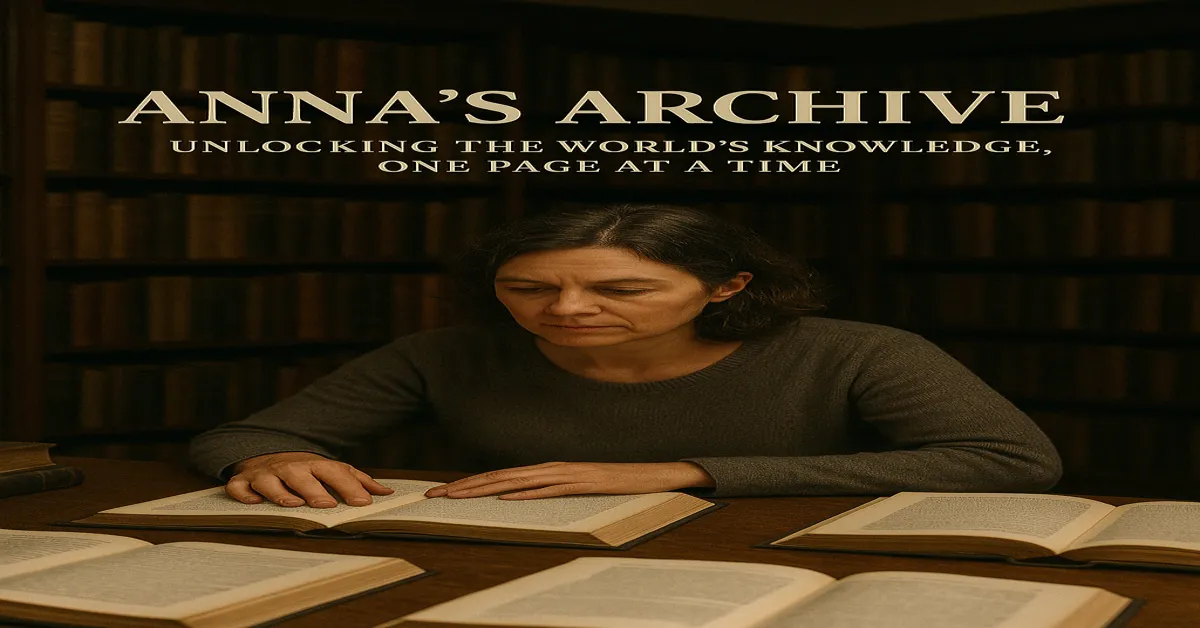Anna’s Archive: Unlocking the World’s Knowledge, One Page at a Time
In a world increasingly driven by information, the power of knowledge access has never been more critical. Whether you’re a student, a researcher, or a lifelong learner, the ability to find and use quality information defines not only academic success but also social and technological advancement. Enter Annas Archive, a revolutionary digital library and data preservation initiative that has quietly emerged as one of the most impactful resources in the world of open access.
What is Anna’s Archive?
Annas Archive is a nonprofit, open-source project that functions as a comprehensive search engine and metadata aggregator for free and pirated digital content — primarily academic texts, books, research papers, and scholarly journals. It does not directly host files but rather indexes content from multiple other repositories, making it a centralized catalog for a vast swath of human knowledge.
Launched in 2022 by activists under the pseudonym “Anna,” the platform was designed to continue the mission of Library Genesis (LibGen), Z-Library, and Sci-Hub, especially after Z-Library’s partial takedown by U.S. authorities. Unlike its predecessors, Anna’s Archive doesn’t just store content — it attempts to archive and preserve it long-term using mirrored databases and decentralized infrastructure.
Chapter 1: The Origins of Annas Archive
The digital preservation community has long battled for access to academic and educational resources. From the early days of Project Gutenberg and Internet Archive to the more controversial rise of Sci-Hub and Z-Library, the open-access movement has evolved in response to the commercial gatekeeping of knowledge.
In late 2022, Z-Library — one of the world’s largest repositories of pirated books — was seized by U.S. authorities, and its founders were arrested. This move threatened access to millions of documents, particularly in countries with limited library infrastructure or where academic materials are unaffordable.
In response, Annas Archive was born.
It was created by a team of digital archivists and coders who wanted to:
- Preserve existing knowledge before it could be taken down.
- Make knowledge globally accessible in the spirit of academic freedom.
- Build an open-source, transparent infrastructure that anyone could improve or mirror.
Chapter 2: What Makes Annas Archive Unique?
While Annas Archive is inspired by previous digital libraries, it distinguishes itself in several key ways:
1. Metadata Aggregation
Rather than simply hosting files, Anna’s Archive acts as an indexer and aggregator, pulling metadata from various sources including:
- LibGen
- Z-Library (pre-seizure backups)
- Sci-Hub
- Internet Archive
- Other decentralized sources and mirrors
This allows it to consolidate results across platforms and provide a more complete picture of what is available.
2. Decentralization and Redundancy
In the wake of takedowns, Anna’s Archive has prioritized digital resilience. It uses torrents, IPFS (InterPlanetary File System), and other decentralized storage solutions to ensure that files remain accessible even if the main site goes down.
3. Open-Source and Transparent
Everything from the site’s code to its backend operations is open-source. This transparency builds trust within the open-access community and allows others to replicate or improve upon it.
4. Not-for-Profit Ethos
Unlike some platforms that monetize content through ads or data collection, Anna’s Archive is explicitly non-commercial. It accepts donations but does not sell user data or run ads.
Chapter 3: Features and Functionalities
1. Universal Search Engine
At the heart of Anna’s Archive is its powerful search engine. You can search by:
- Title
- Author
- ISBN
- DOI
- File type (PDF, EPUB, MOBI, etc.)
- Language
The search is fast, intuitive, and returns results from across multiple libraries simultaneously.
2. Direct Download Links
When a file is available, Anna’s Archive provides direct download links from multiple mirrors, reducing dependency on a single source and improving reliability.
3. Citation and Metadata Tools
Academic users will appreciate the ability to copy citations in formats like MLA, APA, and Chicago. Metadata is detailed and includes publication info, ISBNs, summaries, and more.
4. Integration with Academic Tools
While still early, developers have begun building browser extensions, API tools, and plugins for integration with research software like Zotero and Obsidian.
Chapter 4: Legal and Ethical Considerations
Anna’s Archive operates in a legal gray area. Hosting or indexing pirated content is illegal in many jurisdictions, particularly when it involves copyrighted academic material. However, its defenders argue that:
- Access to knowledge is a human right.
- The traditional publishing industry exploits academic labor — researchers write and review for free, yet journals charge exorbitant fees.
- Barriers to knowledge reinforce inequality, particularly in the Global South.
Legally, Anna’s Archive has taken measures to minimize risk:
- It does not host content itself, only metadata.
- It allows users to remove content (though practically, this is rarely done).
- It uses decentralized systems to reduce reliance on any one jurisdiction.
The debate continues, but many see Anna’s Archive as part of a growing digital civil disobedience movement against the commercialization of knowledge.
Chapter 5: Impact on Academia and Society
1. Leveling the Playing Field
For students and researchers in countries without strong academic infrastructures, Anna’s Archive is a lifeline. Universities in the developing world often cannot afford subscriptions to top-tier journals or textbooks. Anna’s Archive makes these resources universally accessible.
2. Accelerating Innovation
With open access to research comes the democratization of innovation. Independent researchers, entrepreneurs, and nonprofits can now explore areas previously gated behind paywalls, leading to new ideas and solutions.
3. Supporting Lifelong Learning
Education doesn’t stop after graduation. Anna’s Archive empowers autodidacts, hobbyists, and professionals to continue learning throughout their lives, without breaking the bank.
Chapter 6: Controversies and Criticisms
Not everyone is a fan of Anna’s Archive. Criticisms include:
- Copyright violations: Many argue the platform undermines the intellectual property rights of authors and publishers.
- Security concerns: Downloading from mirrors can pose cybersecurity risks if users aren’t cautious.
- Sustainability: Questions remain about how the site will stay online without funding or commercial support.
Despite this, the platform has received overwhelming support from students, researchers, and open-access advocates.
Chapter 7: Anna’s Archive vs Other Platforms
| Feature | Anna’s Archive | Z-Library | Sci-Hub | Internet Archive |
|---|---|---|---|---|
| Academic Focus | High | Medium | High | Medium |
| Book Coverage | Extensive | Extensive | Low (focus on papers) | Moderate |
| Peer-Reviewed Papers | Many (via Sci-Hub) | Some | Yes | Few |
| Open Source | Yes | No | No | Yes |
| Decentralized | Yes | No | Partial | Partial |
Anna’s Archive essentially combines the strengths of multiple platforms while striving for permanence and openness.
Chapter 8: How to Use Anna’s Archive Safely and Ethically
Here are some tips for using Anna’s Archive responsibly:
- Verify the file source – Use trusted mirrors and check file types before downloading.
- Use a VPN – Protect your privacy if accessing the site from regions with strict IP laws.
- Support authors when possible – If you find a book useful, consider buying it or supporting the author.
- Use downloads for personal, educational use – Avoid distributing or commercializing content.
- Stay informed – Understand the legal and ethical landscape of your country regarding digital content access.
Chapter 9: The Future of Anna’s Archive
As of 2025, Anna’s Archive continues to grow, with millions of files indexed and new features under development. Potential future upgrades include:
- Mobile-friendly interfaces and apps
- More languages and localization
- User contributions and community reviews
- Advanced filtering for better searchability
- Collaboration with open-access journals
The goal? Nothing short of a universal, open, and permanent library of all human knowledge.
Chapter 10: Why Anna’s Archive Matters
In the grand history of libraries — from the Library of Alexandria to Google Books — Anna’s Archive stands out as a modern monument to freedom of information. It operates quietly, without the splash of mainstream media attention, yet its impact ripples through academic forums, universities, and communities of readers worldwide.
At a time when digital platforms are increasingly controlled by corporate interests, Anna’s Archive reminds us of a simple, powerful truth: knowledge belongs to everyone.
Whether you’re a first-year college student, a veteran researcher, or just someone with a passion for learning, Anna’s Archive is a beacon of possibility — an internet sanctuary where ideas remain free, preserved, and accessible.
Final Thoughts
The digital age was supposed to make information easier to access. But somewhere along the way, knowledge became a commodity — locked behind paywalls, bundled in overpriced textbooks, and rationed by institutions. Anna’s Archive is not just a tool; it’s a statement. A rebellion. A gift to the world.
So the next time you’re struggling to find a journal article or a rare textbook, remember: Anna’s Archive is there — quietly indexing the corners of the internet so you can unlock the future.





